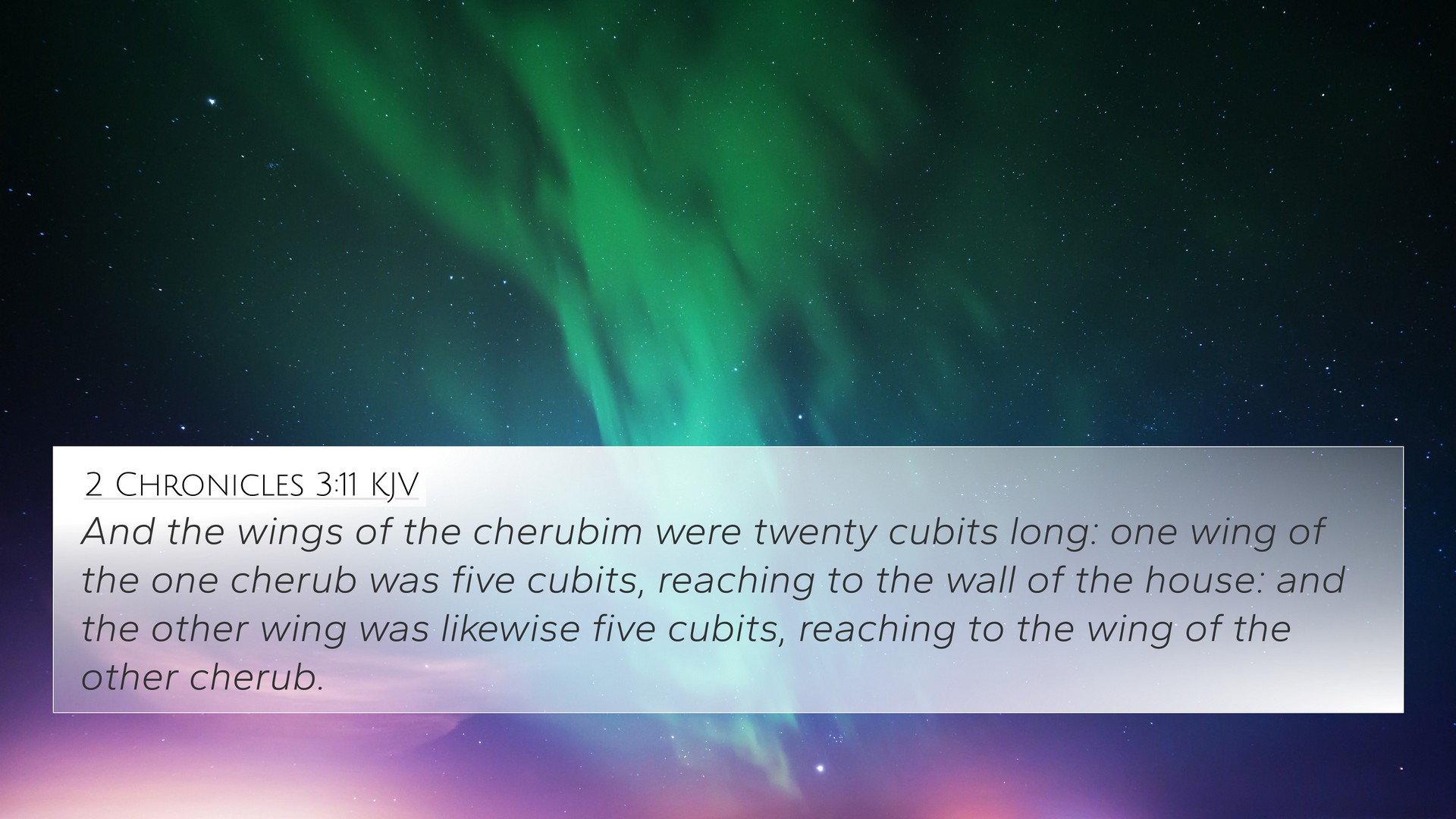Understanding 2 Chronicles 3:11
2 Chronicles 3:11 reads: "And the wings of the cherubim were twenty cubits long; one wing of the one cherub was five cubits, reaching to the wall of the house: and the other wing was likewise five cubits: the other cherub was also five cubits: both the cherubim spread forth their wings on high, covering the seat with their wings, and their faces were inward; and the faces of the cherubim were toward the place of the seat."
Summary of the Verse
This verse describes the grand architectural features of the Temple built by Solomon, particularly focusing on the cherubim that were crafted to inhabit the most holy place. The dimensions and arrangement of the cherubim illustrate both the majesty of God's presence and the reverence with which the dwelling place of God was constructed.
Interpretations from Public Domain Commentaries
Matthew Henry
Matthew Henry notes that the depiction of the cherubim serves to remind worshippers of the divine presence among them. He emphasizes the symbolic nature of the cherubim, which represent protection and the sacredness of God's throne. The details regarding the wings' measurements and their positioning highlight the grandeur of God's holiness and majesty.
Albert Barnes
Albert Barnes elaborates on the craftsmanship of the cherubim, calling attention to their significance in the Jewish worship context. He indicates that these figures, with their expansive wings, signify both the ministry of angels and the heavenly realm's involvement in earthly matters. The connection between God's earthly sanctuary and heavenly sanctuary is made evident through these representations.
Adam Clarke
Adam Clarke provides further insights into the symbolism of the cherubim in relation to Israel's worship practices. He interprets their positioning and form not just as artistic details but as vital theological affirmations. The cherubim's wings enveloping the mercy seat indicate God's readiness to extend grace and mercy, reinforcing the accessibility of divine forgiveness and the serious nature of approaching God.
Thematic Connections
This verse can be cross-referenced with several other biblical texts, illustrating connections and thematic explorations. Below are some important cross-references:
- Exodus 25:18-20: Discusses the instructions for making the cherubim that overshadow the mercy seat, paralleling the description found in 2 Chronicles 3:11.
- 1 Kings 6:23-28: Provides a parallel account of the construction of the cherubim in Solomon’s temple, reinforcing the detailed vision for God’s dwelling place.
- Psalms 80:1: A petition for God to lead His people, reminding them of the cherubim as symbolic of God’s presence and guidance.
- Hebrews 9:5: Mentions the cherubim as part of the tabernacle's symbolism, providing insight into the significance of the mercy seat within the heavenly realm.
- Ezekiel 10:1-22: Offers a vision of the cherubim, which illustrates the heavenly counterpart of what was constructed in the earthly temple.
- Revelation 4:6-8: Describes living creatures (similar in function to cherubim) in the heavenly throne room, emphasizing the continuous worship of God.
- Isaiah 37:16: A prayer acknowledging God as the one who dwells between the cherubim, highlighting God's throne and authority.
Significance of Cross-Referencing
Understanding 2 Chronicles 3:11 within the context of cross-references enhances its meaning significantly. Some benefits include:
- Deepening Understanding: By citing paralleling texts, readers can gather a more holistic view of the biblical narratives and themes.
- Thematic Continuity: Linking Bible scriptures emphasizes overarching theological themes, such as God’s holiness and His desire for communion with humanity.
- Contextual Clarity: Cross-referencing allows for a clearer understanding of specific terms or symbols used across different books of the Bible.
Practical Tools for Cross-Referencing
For those looking to explore cross-references, various tools can be utilized:
- Bible Concordance: A comprehensive index of words found in the Bible, making it easier to locate verses related to specific themes or concepts.
- Bible Cross-Reference Guide: These guides provide side-by-side verses that relate to each other, facilitating an understanding of interconnections.
- Cross-Reference Bible Study Methods: Approaches that encourage studying related verses together to uncover deeper meanings.
Conclusion
The portrayal of the cherubim in 2 Chronicles 3:11 not only emphasizes their artistic magnificence but also their rich theological significance. By employing tools for cross-referencing and exploring inter-Biblical dialogue, readers can gain a profound understanding of this verse and its connections to the wider biblical narrative.


